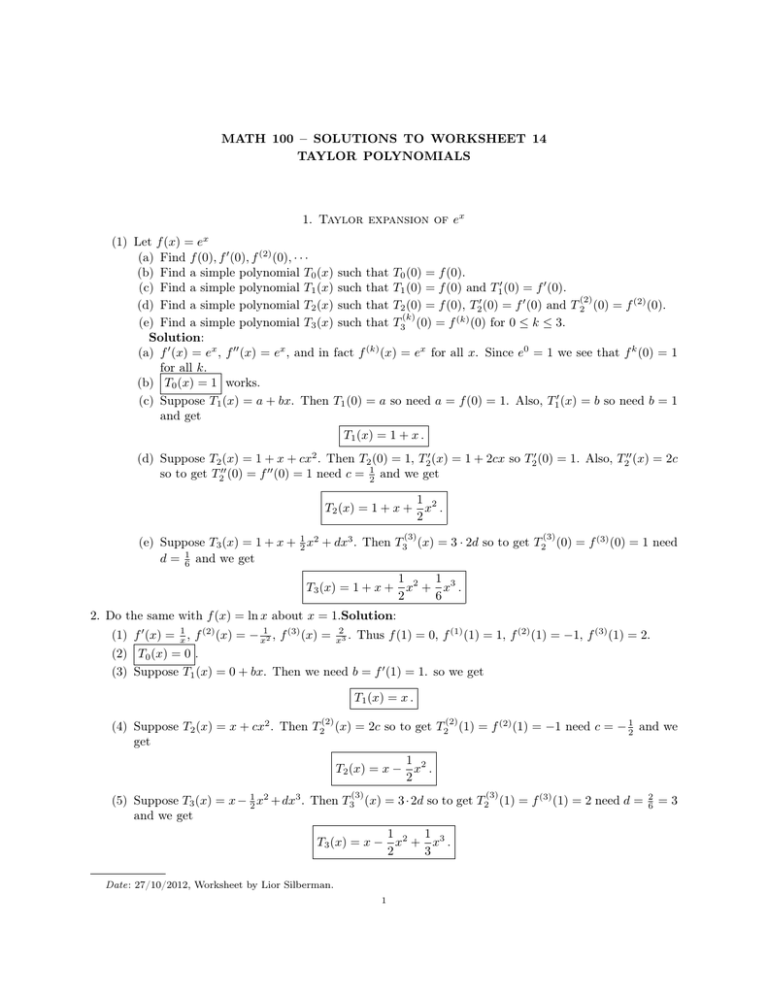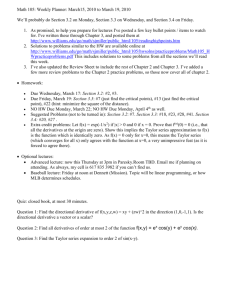MATH 100 – SOLUTIONS TO WORKSHEET 14 TAYLOR POLYNOMIALS
advertisement

MATH 100 – SOLUTIONS TO WORKSHEET 14 TAYLOR POLYNOMIALS 1. Taylor expansion of ex (1) Let f (x) = ex (a) Find f (0), f 0 (0), f (2) (0), · · · (b) Find a simple polynomial T0 (x) such that T0 (0) = f (0). (c) Find a simple polynomial T1 (x) such that T1 (0) = f (0) and T10 (0) = f 0 (0). (2) (d) Find a simple polynomial T2 (x) such that T2 (0) = f (0), T20 (0) = f 0 (0) and T 2 (0) = f (2) (0). (k) (e) Find a simple polynomial T3 (x) such that T3 (0) = f (k) (0) for 0 ≤ k ≤ 3. Solution: (a) f 0 (x) = ex , f 00 (x) = ex , and in fact f (k) (x) = ex for all x. Since e0 = 1 we see that f k (0) = 1 for all k. (b) T0 (x) = 1 works. (c) Suppose T1 (x) = a + bx. Then T1 (0) = a so need a = f (0) = 1. Also, T10 (x) = b so need b = 1 and get T1 (x) = 1 + x . (d) Suppose T2 (x) = 1 + x + cx2 . Then T2 (0) = 1, T20 (x) = 1 + 2cx so T20 (0) = 1. Also, T200 (x) = 2c so to get T200 (0) = f 00 (0) = 1 need c = 21 and we get 1 T2 (x) = 1 + x + x2 . 2 (3) (3) (e) Suppose T3 (x) = 1 + x + 12 x2 + dx3 . Then T3 (x) = 3 · 2d so to get T2 (0) = f (3) (0) = 1 need d = 61 and we get 1 1 T3 (x) = 1 + x + x2 + x3 . 2 6 2. Do the same with f (x) = ln x about x = 1.Solution: (1) f 0 (x) = x1 , f (2) (x) = − x12 , f (3) (x) = 2 x3 . Thus f (1) = 0, f (1) (1) = 1, f (2) (1) = −1, f (3) (1) = 2. (2) T0 (x) = 0 . (3) Suppose T1 (x) = 0 + bx. Then we need b = f 0 (1) = 1. so we get T1 (x) = x . (2) (2) (4) Suppose T2 (x) = x + cx2 . Then T2 (x) = 2c so to get T2 (1) = f (2) (1) = −1 need c = − 21 and we get 1 T2 (x) = x − x2 . 2 (3) (3) (5) Suppose T3 (x) = x − 21 x2 + dx3 . Then T3 (x) = 3 · 2d so to get T2 (1) = f (3) (1) = 2 need d = and we get 1 1 T3 (x) = x − x2 + x3 . 2 3 Date: 27/10/2012, Worksheet by Lior Silberman. 1 2 6 =3 2. General formula The nth order Taylor expansion of f (x) about x = a is the polynomial Tn (x) = c0 + c1 (x − a) + · · · + cn (x − a)n where ck = f (k) (a) k! . 1 (1) Find the 4th order Maclaurin expansion of 1−x . 1 1 (1) (2) Solution: For f (x) = 1−x we have f (x) = (1−x) (x) = 2, f 2·3·4 (1−x)5 . (1) 2 (1−x)3 , f (3) (x) = (2) We therefore have f (0) = 1 = 0!, f (0) = 1 = 1!, f (0) = 2!, f and hence 0! 1! 2! 3! 4! T4 (x) = + x + x2 + x3 + x4 0! 1! 2! 3! 4! = (3) 2·3 (4) (x) (1−x)4 , f (4) (0) = 3!, f = (0) = 4! 1 + x + x2 + x3 + x4 . (2) Find the nth order expansion of cos x. Solution: For g(x) = cos x the derivatives are g (0) (x) = cos x, g (1) (x) = − sin x, g (2) (x) = − cos x, (3) g (x) = sin x, g (4) (x) = cos x and then the derivatives repeat. It follows that the derivatives at zero are 1, 0, −1, 1, and then repeat periodically. We conclude that the odd terms all vanish, and the even terms are the same as those of ex but switch sign: cos x ≈ 1 − 1 1 1 (−1)n 2n 1 2 x + x4 − x6 + x8 − · · · + x . 2! 4! 6! 8! (2n)! 3. New from old √ √ (1) Find the 3rd order Taylor expansion of x about x = 4 and use it to approximate 4.1. √ Solution: Let f (x) = x, a = 4. Then f 0 (x) = 12 x−1/2 , f (2) (x) = − 41 x−3/2 , f (3) (x) = 38 x−5/2 . 1 3 , f (3) (4) = 256 . We have Therefore f (4) = 2, f 0 (4) = 14 , f (2) (4) = − 32 T3 (x) = = = f (2) (a) f (3) (a) f (a) + f 0 (a)(x − a) + (x − a)2 + (x − a)3 2! 3! 1 1 1 1 3 2 + (x − 4) + − (x − 4)2 + (x − 4)3 4 2 32 6 256 1 1 1 (x − 4)3 . 2 + (x − 4) − (x − 4)2 + 4 64 512 For us x = 4.1 so x − a = 4.1 − 4 = √ 1 10 and we get 4.1 ≈ T3 (4.1) = 2 + 1 1 1 − + . 40 6400 512, 000 √ (2) Find the 3rd order Taylor expansion of x + 3x about x = 4. √ Solution: We already know the expansion of x. For 3x the value at 4 is 12 and the slope is 3 so 3x = 12 + 3(x − 4). Thus √ 1 1 1 1 3 2 3 x + 3x ≈ 2 + (x − 4) + − (x − 4) + (x − 4) + (12 + 3(x − 4)) 4 2 32 6 256 = 1 1 1 14 + 3 (x − 4) − (x − 4)2 + (x − 4)3 . 4 64 512 2 (3) Find the 8th order expansion of f (x) = ex + cos(2x). What is f (6) (0)? 1 4 Solution: We already know that ey ≈ 1 + y + 21 y 2 + 16 y 3 + 24 y to fourth order. Plugging in x2 we find 2 1 1 1 ex ≈ 1 + x2 + x4 + x6 + x8 2 6 24 2 (and see that terms y k with k > 4 would give terms x2k with 2k > 8 so not relevant). Similarly, 1 4 1 6 1 8 using cos y ≈ 1 − 12 y 2 + 24 y − 6! y + 8! y and plugging in y = 2x we get 1 1 1 1 cos(2x) ≈ 1 − (2x)2 + (2x)4 − (2x)6 + (2x)8 2 24 6! 8! 4 2 8 2 x . = 1 − 2x2 + x4 − x6 + 3 45 215 We conclude that the 8th order expansion is: 1 2 4 1 4 1 2 x2 2 6 e + cos(2x) ≈ (1 + 1) + (1 − 2)x + ( + )x + − x + + x8 2 3 6 45 24 315 = 7 7 121 8 2 − x2 + x4 + x6 + x . 6 90 2520 We now use the Taylor expansion rule in reverse: the coefficient of x6 is f and f (6) (0) = (6) (0) 7 = 6! 90 1·2·3·4·5·6·7 = 56 . 2·5·9 3 7 90 , but it is also f (6) (0) 6! so




